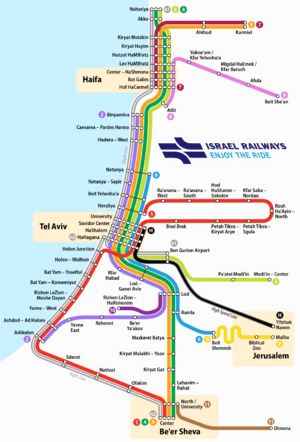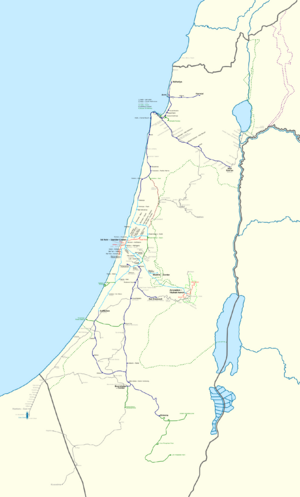Israel Railways facts for kids
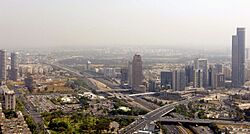
Aerial view of Tel Aviv Savidor Central railway station
|
|
| State owned | |
| Industry | Railways |
| Headquarters | Lod railway station,
Lod
,
|
|
Area served
|
Israel |
|
Key people
|
Michael Maixner (CEO) |
| Services | Rail transport, Cargo transport |
| Revenue | |
|
Operating income
|
|
| Owner | Government of Israel |
|
Number of employees
|
4,366 (2022) |
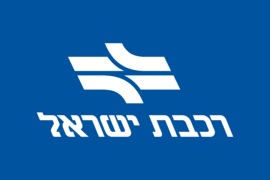 |
|
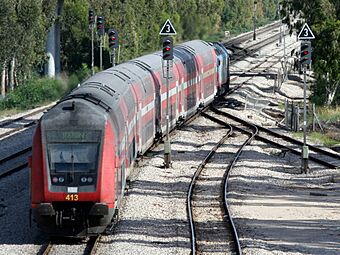 |
|
| Overview | |
|---|---|
| Stations called at | 66 |
| Locale | |
| Dates of operation | 1948–present |
| Technical | |
| Track gauge | 1,435 mm (4 ft 8 1⁄2 in) |
| Electrification | In the process of conversion to electric; 25 kV, 50 Hz overhead wire (60% complete) |
| Length | 1,138 km |
Israel Railways Ltd. (Hebrew: רַכֶּבֶת יִשְׂרָאֵל, Rakevet Yisra'el) is the state-owned principal railway company responsible for all inter-city, commuter, and freight rail transport in Israel. Israel Railways network consists of 1,138 kilometers (707 mi) of track. All its lines are standard gauge. The network is centered in Israel's densely populated coastal plain, from which lines radiate out in many directions. In 2018, Israel Railways carried 68 million passengers.
Unlike road vehicles and city trams, Israeli heavy rail trains run on the left hand tracks, matching neighboring Egypt and other Middle Eastern countries, whose formerly connected rail networks were constructed by British engineers.
Until 1980, the company's head office was located at Haifa Center HaShmona railway station. Tzvi Tzafriri, the general manager of Israel Railways, decided to move the head office to Tel Aviv Savidor Central Railway Station. In 2017, the company's head office was moved to a new campus built on the grounds of the Lod railway station.
Contents
Stations
There are 66 stations on the Israel Railways network, with almost all of the stations being accessible to disabled persons, with public announcement and passenger information systems, vending machines and parking.
Bicycle policy
Bicycles are permitted on trains in designated coaches.
Israel Railways encourages people to use bicycles by building a double-deck parking for bicycles in every railway station and by allowing people to take bicycles with them on trains to minimise the need for private cars.
Smoking
In Israel, smoking is prohibited in public enclosed places and in commercial areas. Although smoking in railway stations is allowed in designated areas, the sale of tobacco from automated vending machines is prohibited.
List of stations
| Station | Passengers | City | District | |||
|---|---|---|---|---|---|---|
| 2019 | 2020 | 2021 | 2022 | |||
| Nahariya | 3,076,039 | 1,241,173 | 1,915,761 | 2,529,474 | Nahariya | Northern District |
| Akko (Acre) | 2,043,343 | 732,180 | 1,067,444 | 1,471,117 | Acre | |
| Afula (R. Eitan) | 776,477 | 268,214 | 495,069 | 722,153 | Afula | |
| Beit She'an | 442,417 | 162,902 | 295,790 | 427,176 | Beit She'an | |
| Migdal HaEmek–Kfar Baruch | 259,977 | 85,531 | 138,467 | 210,073 | Kfar Baruch | |
| Yokneam–Kfar Yehoshua | 339,789 | 122,210 | 224,054 | 327,172 | Kfar Yehoshua | |
| Ahihud | 276,018 | 102,243 | 148,278 | 199,027 | Ahihud | |
| Karmiel | 1,923,674 | 675,621 | 1,119,308 | 1,468,695 | Karmiel | |
| Kiryat Motzkin | 2,376,278 | 844,709 | 1,317,716 | 1,766,157 | Kiryat Motzkin + Haifa | Haifa District |
| Kiryat Haim | 480,814 | 171,289 | 257,428 | 350,175 | Haifa | |
| Hutzot HaMifratz | 626,017 | 245,094 | 419,471 | 567,226 | ||
| HaMifratz Central | 2,984,821 | 1,113,062 | 1,642,487 | 2,774,923 | ||
| Haifa Center HaShmona | 2,242,279 | 773,862 | 1,066,835 | 1,662,346 | ||
| Haifa Bat Galim | 2,282,213 | 874,919 | 1,480,565 | 1,906,404 | ||
| Haifa Hof HaCarmel (S. Raziel) | 4,648,766 | 1,630,110 | 2,425,278 | 3,304,744 | ||
| Atlit | 363,614 | 143,931 | 254,038 | 346,930 | Atlit | |
| Binyamina | 3,336,093 | 1,206,294 | 1,954,827 | 2,659,029 | Binyamina-Giv'at Ada | |
| Caesarea–Pardes Hanna | 1,339,506 | 477,264 | 749,923 | 998,446 | Pardes Hanna-Karkur + Caesarea | |
| Hadera West | 2,430,825 | 879,112 | 1,424,860 | 1,990,340 | Hadera | |
| Netanya | 3,563,026 | 1,212,729 | 1,596,659 | 2,508,795 | Netanya | Central District |
| Netanya Sapir | 1,155,205 | 407,584 | 630,966 | 958,546 | ||
| Beit Yehoshua | 2,056,937 | 675,390 | 1,052,922 | 1,469,031 | Beit Yehoshua | |
| Herzliya | 3,004,648 | 1,008,077 | 1,795,033 | 3,287,493 | Herzliya | Tel Aviv District |
| Ra'anana West | 265,006 | 58,882 | 120,302 | 379,791 | Ra'anana + Herzliya | Central District |
| Ra'anana South | 233,114 | 50,494 | 68,938 | 149,799 | Ra'anana + Kfar Saba | |
| Hod HaSharon Sokolov | 926,654 | 185,951 | 247,703 | 513,615 | Hod HaSharon + Kfar Saba | |
| Kfar Saba Nordau (A. Kostyuk) | 1,373,963 | 286,105 | 398,644 | 817,390 | ||
| Rosh HaAyin North | 1,573,945 | 475,460 | 519,834 | 1,111,224 | Rosh HaAyin | |
| Petah Tikva Segula | 905,440 | 237,701 | 221,772 | 477,782 | Petah Tikva | |
| Petah Tikva Kiryat Aryeh | 1,943,818 | 528,942 | 477,782 | 1,145,391 | ||
| Bnei Brak | 1,271,141 | 320,820 | 282,841 | 604,381 | Bnei Brak | Tel Aviv District |
| Tel Aviv University | 6,499,857 | 1,883,810 | 3,132,561 | 4,931,804 | Tel Aviv | |
| Tel Aviv Savidor Central | 13,426,398 | 4,980,537 | 6,476,362 | 9,384,612 | Tel Aviv + Ramat Gan | |
| Tel Aviv HaShalom | 15,352,944 | 5,635,092 | 8,425,111 | 13,220,102 | Tel Aviv | |
| Tel Aviv HaHagana | 6,596,080 | 2,516,573 | 3,659,147 | 5,309,215 | ||
| Holon Junction | 629,715 | 182,892 | 162,413 | 376,879 | Holon + Tel Aviv | |
| Holon Wolfson | 823,403 | 281,062 | 256,297 | 615,392 | ||
| Bat Yam Yoseftal | 1,810,003 | 584,714 | 685,830 | 1,199,082 | Holon + Bat Yam | |
| Bat Yam Komemiyut | 934,648 | 288,396 | 274,700 | 611,642 | ||
| Ben Gurion Airport (closed March 2020–April 2021; alighting only November 2021–January 2022) |
4,383,073 | 788,867 | 881,276 | 2,948,403 | Ben Gurion Airport | Central District |
| Kfar Habad | 416,411 | 163,848 | 267,515 | 393,541 | Kfar Chabad | |
| Lod Ganei Aviv | 525,198 | 215,892 | 305,990 | 386,895 | Lod | |
| Lod | 2,489,889 | 965,369 | 1,283,229 | 1,735,282 | ||
| Ramla | 861,166 | 336,700 | 452,460 | 668,712 | Ramla | |
| Paatei Modi'in | 391,832 | 120,963 | 225,461 | 515,597 | Modi'in-Maccabim-Re'ut | |
| Modi'in Central | 1,711,198 | 594,652 | 957,050 | 1,762,050 | ||
| Beit Shemesh | 930,014 | 316,171 | 482,584 | 629,960 | Beit Shemesh | Jerusalem District |
| Jerusalem Yitzhak Navon | 2,674,840 | 1,651,659 | 3,598,443 | 6,536,393 | Jerusalem | |
| Biblical Zoo (closed from March 2020) |
26,445 | 1,403 | — | — | ||
| Jerusalem Malha (closed from March 2020) |
115,118 | 17,744 | — | — | ||
| Rishon LeZion Moshe Dayan | 2,217,849 | 596,198 | 670,612 | 1,296,274 | Rishon LeZion | Central District |
| Rishon LeZion HaRishonim (was closed from December 2021 to September 2022) |
360,136 | 111,024 | 137,386 | 36,809 | ||
| Be'er Ya'akov | 777,819 | 294,761 | 444,211 | 569,267 | Be'er Ya'akov | |
| Rehovot | 3,855,766 | 1,395,040 | 1,654,749 | 2,199,938 | Rehovot | |
| Yavne West | 1,465,638 | 483,214 | 647,974 | 1,188,447 | Yavne | |
| Yavne East | 470,468 | 154,927 | 169,294 | 284,367 | ||
| Mazkeret Batya | 243,989 | 177,890 | 315,499 | 457,064 | Mazkeret Batya | |
| Ashdod Ad Halom | 3,765,864 | 1,273,176 | 1,590,702 | 2,727,842 | Ashdod | Southern District |
| Ashkelon | 3,005,131 | 1,026,198 | 1,220,611 | 2,290,614 | Ashkelon | |
| Sderot | 1,025,670 | 359,793 | 398,278 | 635,242 | Sderot | |
| Netivot | 970,450 | 382,667 | 480,892 | 710,581 | Netivot | |
| Ofakim | 864,528 | 331,842 | 415,333 | 575,277 | Ofakim | |
| Kiryat Mal'akhi–Yoav | 360,569 | 135,497 | 233,242 | 320,860 | Kfar Menahem | |
| Kiryat Gat | 1,175,058 | 479,342 | 714,533 | 1,018,644 | Kiryat Gat | |
| Lehavim–Rahat | 438,867 | 158,862 | 246,747 | 316,435 | Lehavim+Rahat | |
| Be'er Sheva North | 2,308,782 | 890,926 | 1,244,946 | 1,822,170 | Beersheba | |
| Be'er Sheva Center | 3,562,792 | 1,331,920 | 2,030,811 | 2,650,516 | ||
| Dimona | 14,745 | 5,278 | 7,969 | 6,397 | Dimona | |
Lines
Israel Railways currently operates 15 passenger service lines. These can be broadly subdivided into inter-city lines, which connect two or more of Israel's major metropolitan centres (Tel Aviv, Jerusalem, Haifa, and Beersheba), usually skipping some of the intermediate stations, and commuter lines, centered on one metropolitan area and serving all stations on the line. However, Israel Railways no longer officially uses this classification.
Some services were partially or fully suspended as a result of the COVID-19 pandemic and electrification works.
Inter-city lines
| Corridor | Service | Terminus (start) | Intermediate stops | Terminus (end) | Infrastructure |
|---|---|---|---|---|---|
| Haifa– Tel Aviv– Beersheba |
Nahariya–Beersheba (partially commuter) ‡ |
Nahariya |
17
Akko
Kiryat Motzkin HaMifrats Central Haifa Center Haifa Bat Galim Haifa Hof HaCarmel Tel Aviv University Tel Aviv Center Tel Aviv HaShalom Tel Aviv HaHagana Lod Ramla Mazkeret Batya Kiryat Mal'akhi-Yoav Kiryat Gat Lehavim-Rahat Be'er Sheva North |
Be'er Sheva Center | Coastal railway Ayalon railway Old Tel Aviv–Jerusalem railway South railway |
| Karmiel–Beersheba ‡ | Karmiel |
15
Ahihud
Akko Kiryat Motzkin HaMifrats Central Haifa Center Haifa Bat Galim Haifa Hof HaCarmel Hadera West Tel Aviv University Tel Aviv Center Tel Aviv HaShalom Tel Aviv HaHagana Lod Kiryat Gat Be'er Sheva North |
Karmiel–Acre railway Coastal railway Ayalon railway Old Tel Aviv–Jerusalem railway South railway |
||
| Haifa– Tel Aviv |
Nahariya–Modi'in (partially commuter) ‡ |
Nahariya |
16
Akko
Kiryat Motzkin Kiryat Haim Hutzot HaMifratz HaMifrats Central Haifa Center Haifa Bat Galim Haifa Hof HaCarmel Atlit Binyamina Tel Aviv University Tel Aviv Center Tel Aviv HaShalom Tel Aviv HaHagana Ben Gurion Airport Pa'atei Modi'in |
Modi'in Center | Coastal railway Ayalon railway New Tel Aviv–Jerusalem railway Anava–Modi'in railway |
(night train, suspended, resuming Feb. 2023) |
Nahariya |
9
Akko
Kiryat Motzkin Haifa Center Haifa Hof HaCarmel Binyamina Hadera West Netanya Tel Aviv Center Tel Aviv HaHagana |
Ben Gurion Airport | Coastal railway Ayalon railway New Tel Aviv–Jerusalem railway |
|
| Tel Aviv– Jerusalem |
Herzliya–Jerusalem † | Herzliya |
5
Tel Aviv University
Tel Aviv Center Tel Aviv HaShalom Tel Aviv HaHagana Ben Gurion Airport |
Jerusalem Yitzhak Navon | Coastal railway Ayalon railway New Tel Aviv–Jerusalem railway |
| Tel Aviv– Jerusalem |
Tel Aviv Center–Jerusalem (night train) † | Tel Aviv Center | Ben Gurion Airport | Jerusalem Yitzhak Navon (closed on Wednesday for maintenance) | Ayalon railway New Tel Aviv–Jerusalem railway |
| Tel Aviv– Beersheba |
(night train, suspended) ‡ |
Tel Aviv Center |
4
Tel Aviv HaHagana
Ben Gurion Airport Lod Kiryat Gat |
Be'er Sheva Center | Ayalon railway New Tel Aviv–Jerusalem railway Old Tel Aviv–Jerusalem railway South railway |
Commuter lines
| Metropolitan core | Service | Terminus (start) | Intermediate stops | Terminus (end) | Infrastructure |
|---|---|---|---|---|---|
| Haifa | Nahariya–Binyamina (inter-city connection) |
Nahariya |
9
Akko
Kiryat Motzkin Kiryat Haim Hutzot HaMifratz HaMifrats Central Haifa Center Haifa Bat Galim Haifa Hof HaCarmel Atlit |
Binyamina inter-city to Modi'in → |
Coastal railway |
| Karmiel–Haifa | Karmiel |
8
Ahihud
Akko Kiryat Motzkin Kiryat Haim Hutzot HaMifratz HaMifrats Central Haifa Center Haifa Bat Galim |
Haifa Hof HaCarmel | Karmiel–Acre railway Coastal railway |
|
| Beit She'an–Atlit | Beit She'an |
7
Afula
Migdal HaEmek-Kfar Baruch Kfar Yehoshua-Yokne'am HaMifrats Central Haifa Center Haifa Bat Galim Haifa Hof HaCarmel |
Atlit | Jezreel Valley railway Coastal railway |
|
| Tel Aviv | Binyamina–Ashkelon (commuter connection) † |
Binyamina |
17
Caesarea-Pardes Hanna
Hadera West Netanya Netanya Sapir Beit Yehoshua Herzliya Tel Aviv University Tel Aviv Center Tel Aviv HaShalom Tel Aviv HaHagana Kfar Chabad Lod Ganei Aviv Lod Be'er Ya'akov Rehovot Yavne East Ashdod Ad Halom |
Ashkelon commuter to Beersheba → |
Coastal railway Ayalon railway Old Tel Aviv–Jerusalem railway Lod–Ashkelon railway |
| Herzliya–Ashkelon † | Herzliya |
18
Ra'anana South
Hod HaSharon Sokolov Kfar Saba Nordau Rosh HaAyin North Petah Tikva Sgula Petah Tikva Kiryat Aryeh Bnei Brak Tel Aviv University Tel Aviv Center Tel Aviv HaShalom Tel Aviv HaHagana Holon Junction Holon Wolfson Bat Yam Yoseftal Bat Yam Komemiyut Rishon LeZion Moshe Dayan Yavne West Ashdod Ad Halom |
Ashkelon | Sharon railway Eastern railway Yarkon railway Ayalon railway Tel Aviv–Bnei Darom railway Lod–Ashkelon railway |
|
| Netanya–Beit Shemesh ‡ | Netanya |
9
Beit Yehoshua
Herzliya Tel Aviv University Tel Aviv Center Tel Aviv HaShalom Tel Aviv HaHagana Lod Ganei Aviv Lod Ramla |
Beit Shemesh | Coastal railway Ayalon railway Old Tel Aviv–Jerusalem railway |
|
| Netanya–Rehovot † | Netanya |
8
Beit Yehoshua
Herzliya Tel Aviv University Tel Aviv Center Tel Aviv HaShalom Tel Aviv HaHagana Kfar Chabad Lod |
Rehovot | Coastal railway Ayalon railway Old Tel Aviv–Jerusalem railway |
|
| Tel Aviv–Modi'in (inter-city connection) |
Tel Aviv University ← inter-city to Nahariya |
5
Tel Aviv Center
Tel Aviv HaShalom Tel Aviv HaHagana Ben Gurion Airport Pa'atei Modi'in |
Modi'in Center | Ayalon railway New Tel Aviv–Jerusalem railway Anava–Modi'in railway |
|
| Lod–Rishon LeZion | Lod | Lod | Rishon LeZion HaRishonim | Lod–Ashkelon railway | |
| Jerusalem | Beit Shemesh | Biblical Zoo | Jerusalem Malha | Old Tel Aviv–Jerusalem railway | |
| Modi'in–Jerusalem † | Modi'in Center | Pa'atei Modi'in | Jerusalem Yitzhak Navon | New Tel Aviv–Jerusalem railway Anava–Modi'in railway |
|
| Beersheba | Lod–Beersheba (inter-city connection) ‡ |
Lod ← inter-city to Nahariya |
6
Ramla
Mazkeret Batya Kiryat Mal'akhi-Yoav Kiryat Gat Lehavim-Rahat Be'er Sheva North |
Be'er Sheva Center | Old Tel Aviv–Jerusalem railway South railway |
| Ashkelon–Beersheba (commuter connection) ‡ |
Ashkelon ← commuter to Binyamina |
4
Sderot
Netivot Ofakim Be'er Sheva North |
Ashkelon–Beersheba railway | ||
| Ashkelon–Beersheba ‡ | Ashkelon |
4
Sderot
Netivot Ofakim Be'er Sheva North |
Ashkelon–Beersheba railway | ||
| Beersheba–Dimona | Be'er Sheva North | – | Dimona | Beersheba–Dimona railway |
† Fully electrified line
‡ Line electrification in progress
Future
The flagship project of Israel Railways is the construction of an improved rail line from Tel Aviv to Jerusalem. The line began as an extension of the current railway to Ben Gurion Airport and Modi'in, and terminates in a new underground station beside the Jerusalem Central Bus Station. An additional proposal will connect Modi'in to Jerusalem if built by connecting to the aforementioned line. The project of electrification, starting with the new Jerusalem-Tel Aviv line is ongoing with plans to eventually electrify all or most of the network.
A 23.5 kilometres (14.6 mi) line from the city of Acre, on the Mediterranean coast, to Karmiel was completed in March 2017. However, this tract bypasses Acre and does not make a stop there; it is planned to be extended north to the north-eastern town of Qiryat Shemona, with future stations also planned for Jadeidi-Makr and Majd al-Krum, though there is no timetable for construction. This line will be fully electrified.
There were plans to build a high-speed railway to Eilat but in 2019 the project was frozen indefinitely.
In 2011 the reconstruction and expansion of the 60 kilometres (37 mi) long, formerly abandoned Jezreel Valley railway line connecting Haifa and Beit Shean (near the Jordanian border) started. This was completed in 2016. There has been talk of further extending the line to Irbid, in Jordan (to allow a direct freight connection from Jordan to the Mediterranean Sea); however, no decision has yet been made on this matter. Another proposed extension under discussion would connect the reconstructed Jezreel Valley railway at Afula to Tiberias.
In May 2017, an extension of the railway from Arad via Kuseife was approved. The line would connect to the existing Beersheba–Dimona rail line at the proposed new station at Nevatim.
Rolling stock
Israel Railways currently owns a total of 193 locomotives, 717 passenger cars, and 110 MU trainsets.
Current
Locomotives
| Class | Image | Type | Top speed | Number | Remarks | Built | Entered service | |
|---|---|---|---|---|---|---|---|---|
| mph | km/h | |||||||
| EMD G12 |  |
Diesel-Electric locomotive | 10 | Bo-Bo. Israel imported 23 from EMD 1954–62 and captured four more from Egyptian National Railways in the 1967 Six-Day War. Some have been withdrawn and one (No. 107) is now in the Israel Railway Museum in Haifa. No. 106 was withdrawn after sabotage. Nos. 119 & 123 withdrawn after incidents. No. 130 never in service due to Six-Day War. | 1954–62 | 1961 | ||
| EMD G26 |  |
14 | 1971–82 | 1971 | ||||
| EMD GT26CW-2 |  |
13 | Number 701 is an original EMD unit delivered in 1989. In the mid-2010s Israel Railways purchased thirteen units from NRE which were completely rebuilt by TŽV Gredelj from 11 Croatian Railways HŽ series 2062 GT26 units plus 2 new frames and designated as NGT26CW-3 variants. They were delivered to Israel Railways between August 2015 and December 2017 and numbered 710–722. | 1989, 2015–17 | 2015 | |||
| Alstom Prima JT 42CW |  |
68 | 110 | 7 | Series 702–709. EMD prime mover. | 1996 | 1997 | |
| Alstom Prima JT 42BW | 87 | 140 | 48 | Series 731–778. EMD prime mover. | 1996–2006 | 1997 | ||
| Vossloh Euro 3200 | 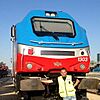 |
100 | 160 | 24 | Series 1301–1324. With modifications capable of 200 km/h. EMD prime mover. | 2011–13 | 2015 | |
| Vossloh Euro 4000 |  |
80 | 130 | 14 | Series 1401–1414. EMD prime mover. | 2011 | 2014 | |
| Bombardier TRAXX P160 AC3 |  |
Electric locomotive | 100 | 160 | 63 (32 options) | Ordered in 2015. 25 kV 50 Hz AC operation. 6 MW electric output. Initial delivery began in 2017. | 2017 | 2018 |
Multiple Units
| Class | Image | Type | Top speed | Number | Remarks | Built | |
|---|---|---|---|---|---|---|---|
| mph | km/h | ||||||
| Siemens Desiro HC |  |
EMU | 100 | 160 | ~60 sets (330 cars) | Siemens won tender in September 2017. Tender called for two basic double-deck sets: 15 short (composed of 4 cars) and 45 long (6 cars). First delivery, consisting of three sets, took place in November 2020. | 2019 |
Carriages
Israel Railways owns a total of 717 passenger cars.
Retired
Locomotives
Steam Locomotives
| Class | Image | Top speed | Number | Remarks | Built | |
|---|---|---|---|---|---|---|
| mph | km/h | |||||
| Baldwin H class |  |
6 | Series 7-12 (H2), 13-17 (H3), 33 of series 871–920. Taken over from Palestine Railways. Last went out of service in 1959 and scrapped in '60. | 1918 | ||
| NBL/Borsig Egyptian 545 class | 4 | 5 captured during 1956 Israeli invasion of Sinai on the former Palestine Railways main line between El Kantara East and Gaza: numbers 546, 550 and 557 (NBL) and numbers 607 and 613 (Borsig). 4 taken into stock and used them around Lod in central Israel for 1–2 years. Withdrawn and scrapped in 1959. | 1928, 1931 | |||
| NBL P class 4-6-0 |  |
6 | Series 60–65. Taken over from Palestine Railways. Last went out of service in 1959 and scrapped in '60. Tender of 62 preserved at Israel Railway Museum. | 1935 | ||
| LMS Stanier Class 8F |  |
23 | Series around 70513. Taken over from Palestine Railways. Last went out of service in 1958. One (the 24th) stranded 8F, 70372 (NBL works no. 24680), on a small section of the main line near Tulkarm on the West Bank side of the 1949 Armistice line.It remained there, increasingly derelict, until after the 1967 Israeli 6 day war. The Israelis finally removed and scrapped it in about 1973. A similar 8F (a Turkish TCDD 45151 Class locomotive) preserved at Be'er Sheva Turkish railway station and numbered 70414. | 1935–46 | ||
| USATC S100 Class | 2 | Number 21 &22 (class 957?). Transported from Europe to Suez in September 1942. To Palestine Railways, later Army. Later to Israel Railways. 1 | 1942 | |||
Diesel Locomotives
| Class | Image | Top speed | Number | Remarks | Built | |
|---|---|---|---|---|---|---|
| mph | km/h | |||||
| SAFB (GM-EMD) |  |
68 | 110 | 3 | BoBo locomotives series 101-103, fitted with EMD 3RSW engines. In service until 1998. First diesel locomotive in IR's service. 102 locomotive is preserved. | 1952 |
| Esslingen |  |
18 | Series 211–228. Similar to DB Class V 60. In the mid-1960s, the Esslingen factory was closed. As a result, some almost-new locomotives were cannibalised for parts. One example preserved at the Railway Museum and another at the Jezreel Valley railway heritage site in Elro'i. | 1955–56 | ||
| Deutz |  |
3 | Series 201-203 shunting locomotives. 203 is preserved under the 201 number | 1958 | ||
| EMD G16 | 3 | Co-Co. During the Six-Day War Israel captured Egyptian Railways 3304, 3329 and 3361 which were appropriated into Israel Railways stock as numbers 301–303, later 161–163. All have now been withdrawn from service but 163 (formerly ER 3361) is preserved at the Israel Railway Museum. | 1960–61 | |||
| GA DE900 |  |
50 | 80 | 3 | Series 261–263. Primarily used for shunting. Withdrawn from service in the early 2020s. One placed on static display near the historic Petah Tikva railway station. | 1997 |
Multiple Units
| Class | Image | Type | Top speed | Number | Remarks | Built | |
|---|---|---|---|---|---|---|---|
| mph | km/h | ||||||
| Esslingen |  |
DMU | 12 | Similar to German VT08. 3-car sets (powered coaches 1-12, intermediate coaches 1-12, driving coaches 1-12), some later extended to 4-unit sets (with intermediate coaches 13-22). In the early sixties converted to non-powered coaches in push-pull service because of high maintenance costs. Withdrawn in 1979. Some carriages continued in regular services from 1992 until nineties as 111–117. One trailer should be preserved by the Country Museum in Tel Aviv | 1956 | ||
| FIAT 7225 | Railcar | 80 | 128 | 0 | 10 ordered. After 8 were finished, the order was cancelled for unclear reasons. Italian literature wrote because of the Yom Kippur War. All ten units were sold to Ferrocarril del Pacifico and Ferrocarril Chihuahua al Pacífico in Mexico, where they entered service in 1975. | 1970/1973 | |
| ABB Scandia IC3 |  |
DMU | 112 | 180 | 9 sets (42-50) | The introduction of IC3-trains in the early 1990s marked the beginning of a political recommitment to major improvements in the services of Israel Railways.
Each IC3 set is composed of 3 cars and multiple sets may be joined together. Sets 42-50 purchased from SJ in 2005. 31 was scrapped after an incident near Revadim on 10 August 2006. 19, 21, 25 possibly out of service. 01 is now in the Israel Railway Museum. |
1990 |
 |
100 | 160 | 10 sets (01-10) | 1992 | |||
| 31 sets (11-41) | 1994–96 | ||||||
Carriages
| Class | Image | Number | Remarks | Built |
|---|---|---|---|---|
| O&K | 8 | 3rd class coaches similar to German Eilzugwagen series 51-58. Seating however different with 2+3 seat arrangement and 96 seats. | 1955 | |
| Carel et Fouché CarF |  |
14 | Picture: first carriage. Series 71-84 | 1961 |
| Boris Kidrič/Metalka "Yugo" |  |
43 | Series 601–643, delivered in several batches between 1964 and 1972. 601-615 in 1964, series 616-625 in 1965, 626-633 in 1966, 634-637 in 1971 and 638-643 in 1972. Coaches 631, 632 and 633 were fitted with buffets. 610 converted to half passenger carriage, half generator car. Some other were converted to full generator carriages. 621 in 2009 used as office in red colors in Bnei Brak. | 1964–72 |
| DEV-Inox Carel et Fouché |  |
8 | Bought from SNCF in 1994 (Series 91-98) to create superfuous coaches for refurbishment by HaArgaz. Original 1st class A9TJ-mainline carriage U64. Declassified to B10 1/2TJ in eighties. Scrapped in 2006. 1 preserved in Railway Museum. | 1965 |
| British Railways Mark 2c TSO |   |
8 (13) | Bought from British Rail in 1977 (Series 681-688 (ex BR 5567, 5570, 5575, 5580, 5588, 5593, 5606, 5612) and retro-fitted with air conditioning equipment at Wolverton Works. 1 preserved at Railway Museum. In 1989, restaurant chain Apropo bought 5 Mk1 (BR 3947, 7675, 18768, 84338) and 1 Mk2 (5250) and shipped these to Israel, never to be used. | 1970 |
| Alstom MoDo |  |
35 | Assembled in Israel by Haargaz and were the first push-pull carriages operated by Israel railways. In August 2022 Israel Railways announced they were pulling the Alstom Modo from service starting September 2022. Driving Coach 302 is preserved on display at Railway Museum. | 1996-1997 |
Organizational structure
The company is headed by a chief executive officer. It has two subsidiaries: a real estate development company, and a freight rail company. The main organization has five operational departments: freight, infrastructure, rolling stock, passengers and development.
In 2017, Israel Railways founded a Tunnels Unit that is responsible for the daily operation of railway tunnels, including lighting, air circulation, etc. and managing emergencies.
Performance
The passenger number history (in millions) is as follows:
| 1950 | 1960 | 1970 | 1980 | 1990 | 1991 | 1995 | 1996 | 1997 | 1998 | 1999 | 2000 | 2001 | 2002 | 2003 | 2004 | 2005 | 2006 | 2007 | 2008 | 2009 | 2010 | 2011 | 2012 | 2013 | 2014 | 2015 | 2016 | 2017 | 2018 | 2019 | 2020 | 2021 | 2022 |
|---|---|---|---|---|---|---|---|---|---|---|---|---|---|---|---|---|---|---|---|---|---|---|---|---|---|---|---|---|---|---|---|---|---|
| 1.6 | 4.4 | 4.1 | 3.3 | 2.5 | 2.9 | 4.8 | 5.1 | 5.6 | 6.4 | 8.8 | 12.7 | 15.1 | 17.5 | 19.8 | 22.9 | 26.8 | 28.4 | 31.8 | 35.1 | 35.9 | 35.9 | 35.9 | 40.4 | 45 | 48.5 | 53 | 59.5 | 64.6 | 67.7 | 69 | 24.2 | 35.0 | 54.7 |
| 1990 | 1995 | 2000 | 2009 | 2010 | 2011 | 2012 | 2013 | 2014 | 2015 | 2016 | 2017 | 2018 | 2019 | 2020 | |
|---|---|---|---|---|---|---|---|---|---|---|---|---|---|---|---|
| Total Revenue (million NIS) | 102 | 200 | 402 | 776 | 840 | 842 | 902 | 997 | 1,095 | 1,158 | 1,102 | 1,159 | 1,155 | 1,146 | 518 |
| Passenger-kilometers (million) | 170 | 267 | 781 | 2,011 | 1,986 | 1,927 | 2,133 | 2,376 | 2,485 | 2,608 | 2,645 | 2,765 | 3,032 | 3,580 | 1,253 |
| Train-kilometers (passenger, million) | 3.812 | 9.375 | 8.905 | 8.767 | 8.348 | 10.035 | 11.17 | 12.101 | 12.92 | 13.767 | 14.137 | 14.796 | 10.158 | ||
| Train-kilometers (cargo, thousand) | 1,498 | 1,571 | 1,609 | 1,508 | 1,556 | 1,584 | 1,782 | 1,817 | 2,063 | 2,141 | 1,934 | 1,934 | 1,791 | ||
| Ton-kilometers (cargo, million) | 1,048 | 1,176 | 1,173 | 799 | 1,062 | 1,099 | 1,011 | 1,058 | 1,165 | 1,155 | 1,404 | 1,381 | 1,235 | 1,241 | 1,250 |
| Network length (km) | 940 | 858 | 926 | 1,001 | 1,035 | 1,079 | 1,138 | 1,153 | 1,194 | 1,277 | 1,337 | 1,384 | 1,462 | 1,462 | 1,486 |
In contemporary shekels – not adjusted for inflation
Notable accidents
- On 26 December 1963 two passenger trains on the then single-track main line linking Tel Aviv and Haifa collided head-on at Bet Yehoshua just south of Netanya. The northbound train had passed a red signal and its locomotive rode over and crushed the locomotive of the southbound train. None of the coaches was derailed but a coupler broke in the northbound train detaching the rear three coaches. The continuous train brake should have then automatically stopped the detached coaches but it had not been connected properly so they started to roll back southwards. 55 people were injured but only three seriously enough to be detained in hospital. The two head-end crews survived but their locomotives, EMD G12s 105 and 118, were destroyed.
- HaBonim disaster: On 11 June 1985 a train collided with a bus carrying school children, killing 19 children and 3 adults, near moshav HaBonim.
- On 21 June 2005 an IC3 train crashed into a freight truck near kibbutz Revadim, killing 8 and injuring 198.
- 8 July 2005, a train collided with a truck between Kiryat Gat and Ahuzam, resulting in the death of the train driver and 38 injuries. In February 2012 a plea bargain had been set for the Revadim crash.
- On 12 June 2006 a train crashed into a truck near Beit Yehoshua, killing 5 and injuring from 77 to over 80.
- On 27 December 2009 a train crashed into a car near Kiryat Gat. The driver proceeded without regard to the train checkpoint on the road. The train struck his car and he was killed.
- On 5 August 2010 a train crashed into a minibus near Kiryat Gat, killing 7 and injuring 6. The minibus was hit at 19:05 GMT+3 on Route 353, apparently as it tried to pass over a level crossing.
- On 28 December 2010 a fire started in a train near kibbutz Yakum, probably because of a short circuit, injuring 116.
- On 7 April 2011 two trains collided frontally near Netanya, injuring 59.
- On 4 October 2013, two men walking along railroad tracks in the Emek Hefer valley industrial zone were killed by a train.
- On 18 December 2013, a Beersheba-bound train collided with a group of camels walking along railroad tracks at the Segev Shalom Junction in the Negev, killing 14 camels. The incident caused massive delays in train traffic.
- On 29 December 2013, an Israel Railways worker was run down and killed by a train near Lod.
- On 15 March 2016, an Israel Railways locomotive crashed into freight wagons, injuring 6.
See also
 In Spanish: Israel Railways para niños
In Spanish: Israel Railways para niños
- Rail transport in Israel
- Hejaz Railway (1908-1920), Ottoman line which connected Damascus with Medina; the Jezreel Valley railway was a branch in its network
- Ottoman Palestine railways
- Eastern Railway, Ottoman WWI line, Tulkarm to Hadera and Tulkarm to Lydda; connected to Jezreel Valley, Jaffa–Jerusalem, and Beersheba lines
- Jaffa–Jerusalem railway (inaugurated 1892)
- Jezreel Valley railway (1905-1948), segment of the Haifa–Dera'a Line which connected the Hejaz Railway to the port of Haifa
- Railway to Beersheba or the 'Egyptian Branch', Ottoman WWI line headed towards the Suez Canal; two lines: (Lidda–) Wadi Surar (Nahal Soreq)–Beit Hanoun, and Wadi Surar–Beersheba
- Mandate Palestine & Israel railways
- Palestine Railways, government-owned company and rail monopolist in Mandate Palestine (1920-1948)
- Coastal railway line, main line in Mandate Palestine and Israel



